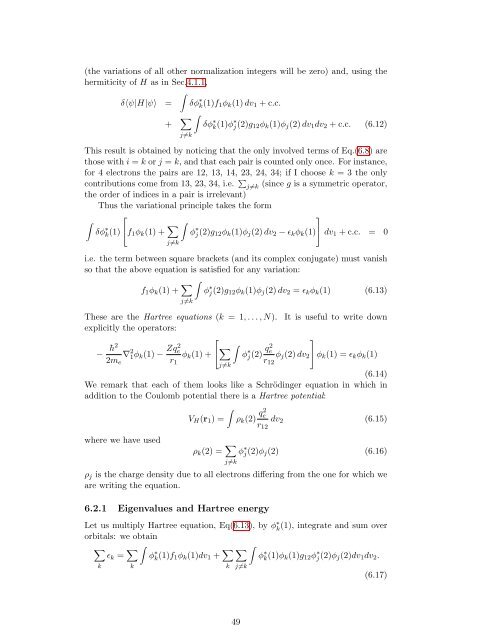Numerical Methods in Quantum Mechanics - Dipartimento di Fisica
Numerical Methods in Quantum Mechanics - Dipartimento di Fisica
Numerical Methods in Quantum Mechanics - Dipartimento di Fisica
You also want an ePaper? Increase the reach of your titles
YUMPU automatically turns print PDFs into web optimized ePapers that Google loves.
(the variations of all other normalization <strong>in</strong>tegers will be zero) and, us<strong>in</strong>g the<br />
hermiticity of H as <strong>in</strong> Sec.4.1.1,<br />
∫<br />
δ〈ψ|H|ψ〉 = δφ ∗ k(1)f 1 φ k (1) dv 1 + c.c.<br />
+ ∑ ∫<br />
δφ ∗ k(1)φ ∗ j(2)g 12 φ k (1)φ j (2) dv 1 dv 2 + c.c. (6.12)<br />
j≠k<br />
This result is obta<strong>in</strong>ed by notic<strong>in</strong>g that the only <strong>in</strong>volved terms of Eq.(6.8) are<br />
those with i = k or j = k, and that each pair is counted only once. For <strong>in</strong>stance,<br />
for 4 electrons the pairs are 12, 13, 14, 23, 24, 34; if I choose k = 3 the only<br />
contributions come from 13, 23, 34, i.e. ∑ j≠k (s<strong>in</strong>ce g is a symmetric operator,<br />
the order of <strong>in</strong><strong>di</strong>ces <strong>in</strong> a pair is irrelevant)<br />
Thus the variational pr<strong>in</strong>ciple takes the form<br />
⎡<br />
⎤<br />
∫<br />
∫<br />
δφ ∗ k(1)<br />
φ ∗ j(2)g 12 φ k (1)φ j (2) dv 2 − ɛ k φ k (1) ⎦ dv 1 + c.c. = 0<br />
⎣f 1 φ k (1) + ∑ j≠k<br />
i.e. the term between square brackets (and its complex conjugate) must vanish<br />
so that the above equation is satisfied for any variation:<br />
f 1 φ k (1) + ∑ ∫<br />
φ ∗ j(2)g 12 φ k (1)φ j (2) dv 2 = ɛ k φ k (1) (6.13)<br />
j≠k<br />
These are the Hartree equations (k = 1, . . . , N). It is useful to write down<br />
explicitly the operators:<br />
⎡<br />
⎤<br />
− ¯h2 ∇ 2<br />
2m<br />
1φ k (1) − Zq2 e<br />
φ k (1) + ⎣ ∑ ∫<br />
φ ∗<br />
e r<br />
j(2) q2 e<br />
φ j (2) dv 2 ⎦ φ k (1) = ɛ k φ k (1)<br />
1 r<br />
j≠k<br />
12<br />
(6.14)<br />
We remark that each of them looks like a Schröd<strong>in</strong>ger equation <strong>in</strong> which <strong>in</strong><br />
ad<strong>di</strong>tion to the Coulomb potential there is a Hartree potential:<br />
where we have used<br />
∫<br />
V H (r 1 ) =<br />
ρ k (2) q2 e<br />
r 12<br />
dv 2 (6.15)<br />
ρ k (2) = ∑ j≠k<br />
φ ∗ j(2)φ j (2) (6.16)<br />
ρ j is the charge density due to all electrons <strong>di</strong>ffer<strong>in</strong>g from the one for which we<br />
are writ<strong>in</strong>g the equation.<br />
6.2.1 Eigenvalues and Hartree energy<br />
Let us multiply Hartree equation, Eq(6.13), by φ ∗ k (1), <strong>in</strong>tegrate and sum over<br />
orbitals: we obta<strong>in</strong><br />
∑<br />
ɛ k = ∑ ∫<br />
φ ∗ k(1)f 1 φ k (1)dv 1 + ∑ ∑<br />
∫<br />
φ ∗ k(1)φ k (1)g 12 φ ∗ j(2)φ j (2)dv 1 dv 2 .<br />
k k<br />
k j≠k<br />
(6.17)<br />
49
















